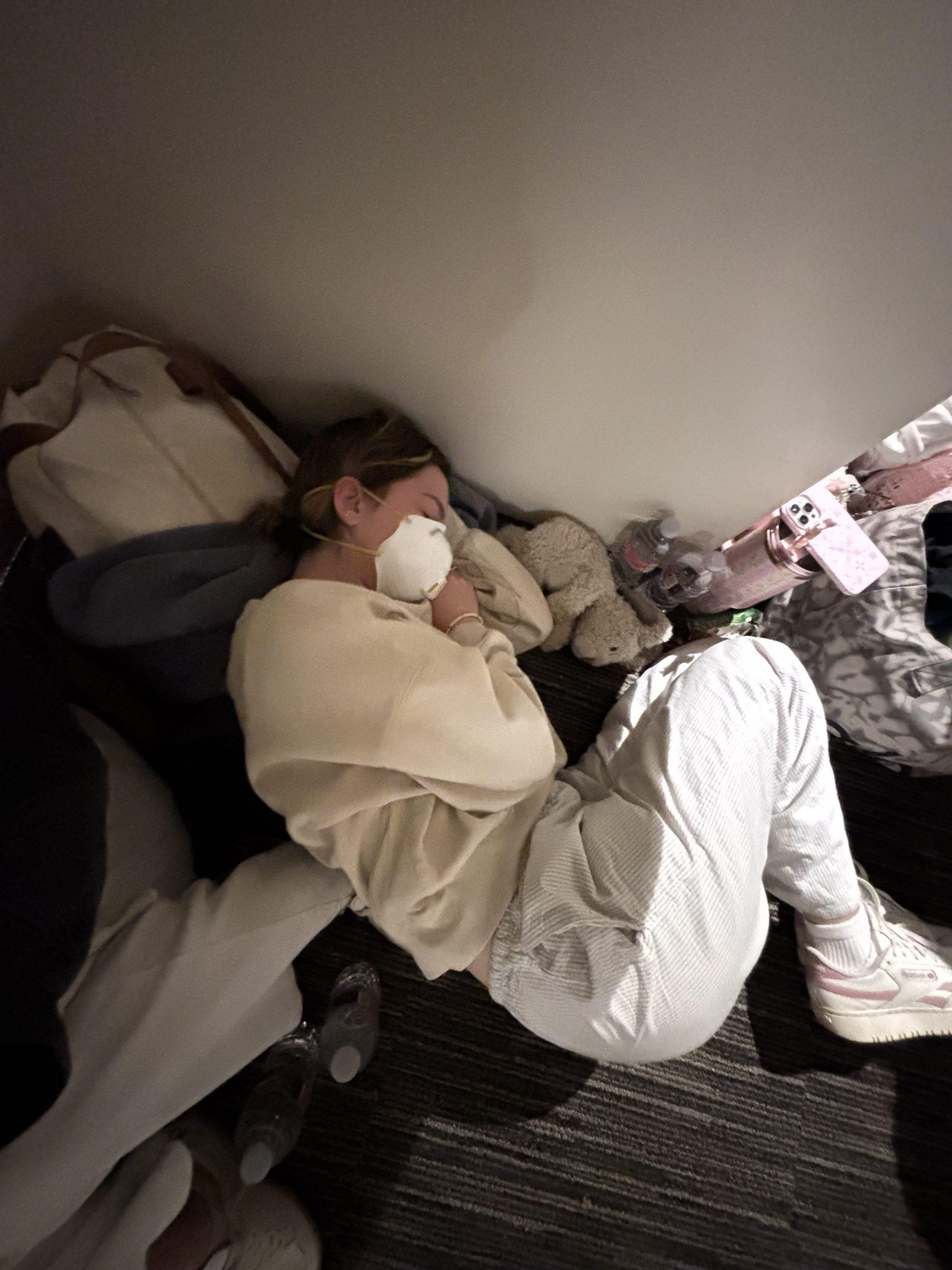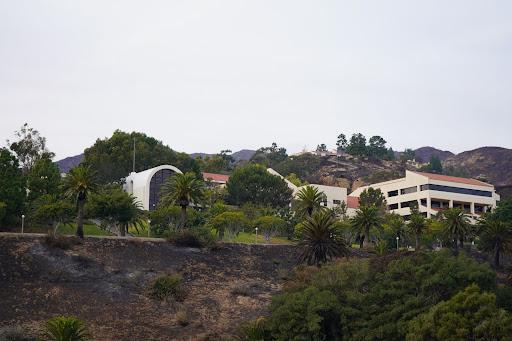
Editor’s note: This part of a reporting series, “From the Flames,” that explores the aftermath of the recent L.A. County fires. In December of 2024, the Franklin Fire ignited in Malibu, burning 4,000 acres and dozens of structures. Students and faculty sheltered in place on campus while flames burned the nearby hillsides. Then, less than a month later, the Palisades Fire exploded, burning more than 23,000 acres in Malibu and the Pacific Palisades. Today, PCH remains closed, homes remain in ruins and the local businesses that are open continue to struggle. Yet, as new growth begins to sprout on the nearby hillsides, there are small signs of recovery as communities begin the long road to recovery.
When the Franklin and Palisades wildfires swept through Malibu, Pepperdine University was caught in the crossfire, and students found themselves sheltering in place as flames closed in.
Now, months later, some students are grappling with the question: Do they feel safer, or has the experience heightened their concerns?
While some said they found reassurance in the university’s preparedness, others said they felt the situation’s intensity firsthand and wrestled with uncertainty. The divide between first-year students and seniors is particularly evident as some are experiencing the dangers of fire season for the first time, while others have lived through multiple emergencies.
“Students likely have different experiences with it,” Maura Page, director of Residence Life, said. “Some probably see all of the planning and preparations and the actions that we took — and that inspire safety — and for some, it was just so close that the amount of preparation we do and the outcome of being safe still doesn’t override that feeling in the moment.”
A Senior Perspective: Experience Brings Familiarity, But Also Fatigue
Senior Albert Covaci described his experience returning to campus after winter break as surreal. His return was met with an unusual sight.
“Once we got on PCH, there were these guards, like people in straight military trucks, people in military uniform blocking off [our way] to go to campus,” Covaci said.” So we had to take the long way around.”
Covaci said he was on campus when the Franklin Fire started, but he was not initially concerned about it.
“As a guy, and as a young guy at that, you feel invincible in a way,” Covaci said. “It wasn’t until I left, going outside while having all my stuff and looking at how close the fire actually is, I started getting the sense of urgency, like, ‘Oh man, we got to leave.'”
Despite the school sheltering in place, he opted to evacuate from the school entirely. He took his brother and suitemate to Westlake and stayed there until they received word it was safe to return to campus.

Covaci said he had evacuated mainly because of the intensity of the media coverage of the fire, which had increased his fears of personal safety.
“I did feel a lot safer leaving campus because you know how the media sometimes gets you,” Covaci said. “I was getting these Snapchats, looking at stories of how close the fire was getting to campus. Seeing that and then seeing the news, like people I knew were on there, I was like, ‘Oh my gosh, thank goodness I left.’”
However, despite his initial concerns, Covaci acknowledged that Pepperdine’s communication was strong — at least in the early stages.
“At the beginning stages, Pepperdine seemed like they were sending a lot of emails in a short amount of time, you know, packed with a lot of information,” Covaci said. “A lot of questions were answered, lot of phone calls, especially the beginning part. I feel like they did a pretty decent job.”
But, after experiencing multiple fires at Pepperdine, he admitted to a sense of desensitization.
“There were multiple fires, and I feel like after, the third, fourth one, it’s just like again? Covaci said. “It got annoying.”
Still, he believes the university is well-prepared for future incidents. He said the university might be slightly on edge with the intensity of recent fires, but they are well-equipped to keep the student body safe.
“Because anything could really happen on any given day,” Covaci said. “I feel like they have what it takes. They’ve always had it, but they’re more on edge.”
When looking back at his decision to evacuate, he said if the situation were to arise again, he would opt to put his faith and trust in Pepperdine’s shelter-in-place protocols.
A First-Year Perspective: Navigating the Unknown
First-year Emma Huddleston had a different experience as a newcomer to Pepperdine.
“I was a little unsure about it at first. I was confused initially, definitely a little scared, a little frightened, but I think that Pepperdine did a very good job keeping the student body informed,” Huddleston said.
Huddleston recalled feeling both anxious and reassured during the protocol. She said that despite the situation — being surrounded by fire — she felt as though she was getting all the necessary updates, helping ease her worries and ushering in safety.
While some students were panicked, scared and crying, she said she found confidence in the university’s emergency preparedness.
“The situation was handled very, very beautifully and very well. Everybody seemed very put together and the RAs knew exactly what to do,” Huddleston said. “Everybody, just the whole Pepperdine faculty made me, my suitemates and my friends feel very, very safe within the library.”
Her parents had opposing reactions to the shelter-in-place protocols.
Her mom disliked the idea of sheltering in place, but her dad was previously familiar with the school’s fire protocols. She said her dad loved the idea that students could shelter themselves in the safest part of the school, Payson Library.
“My dad wasn’t worried at all, but my mom was worried,” Huddleston said. “She wanted me to get in my car and come home right away, but she’s very high emotion, so I think that was just her wanting me to be safe. But my dad knew that I was safe in the library.”
However, despite Huddleston’s praise for what she called the school’s strong early and digital communication, she said in-person instructions could have been clearer.
“My only critique about the whole thing is I wish there was a little more communication in-person,” Huddleston said. “Because I felt like it was a lot of like yelling to like, ‘OK, you go there, you go there’ and we didn’t know why. It would have been better if there was a little more truth and communication on the in-person part.”

But, similarly to Cocavi, she expressed trust in the school’s ability to handle future emergencies. She said she believes the protocols the schools set forth kept the students safe and will continue to in future emergencies.
Huddleston said that although the fires and protocols were not what she had in mind for her first year in college, she does not feel less safe being here.
“I still think the campus did a very amazing job at keeping everybody safe, and overall, communication was great, and I applaud them for how they handled the situation,” Huddleston said. “I definitely am nervous about future fires, but I also know that Pepperdine can handle it, and so that kind of makes me feel secure.”
The University Areas of Strength and Improvement
Page said in her experience following the fires, student responses varied depending on their individual experiences with the fire.
“I think it’s mixed,” Page said. “I think a number of students, and probably all students, experience the fire as it is, a scary experience.”
She highlighted that while some students trusted the university’s preparedness, others were overwhelmed by the fire’s proximity and challenges the fire would present. Some of these challenges involved communication, and Page said the university continues to address communication challenges, particularly during power and Wi-Fi outages.
“Most people are not used to seeking out an in-person communication, especially during an emergency,” Page said. “So we’re looking at that and how we can make improvements for students during those experiences.”
Page said Residence Life has a number of protocols they follow during these instances. They are developed with the mindset of ensuring students are well-informed and supported during a time of crisis.
“One of them is going door to door during an emergency, so the student leaders literally knock on every single door in all of housing,” Page said.
RAs check every single bed, bathroom and living space ensuring that students are aware of what’s happening, they know where to go, they know to grab some essential items and to take them with them, Page said.

Page was present during the Woolsey Fire in 2018, and through her experience, she said the students who remained on campus often felt more secure than those who evacuated.
On top of this, during the Woolsey Fire, she said students who lived off-campus evacuated to Pepperdine, emphasizing the trust and safety the campus provides its students, as well as the robust care and support the university offers.
“When you live off campus, you don’t have provisions during an incident like this, there’s nobody saying, ‘Come spend the night in this building,’ or ‘We’ll have food for you,’” Page said. “We’ll provide all the meals for you during this time, or there’s support resources available.”
For some students, the repeated exposure to fire emergencies has dulled the sense of urgency during a time of crisis. For others, it has reinforced the importance of preparedness and trust in the university’s protocols.
Some students, like Huddleston, felt safe and supported during the shelter-in-place, while others, like Covaci, found themselves questioning whether to stay or leave. Despite varying perspectives, both students agreed that preparation is key, and Page said Pepperdine remains committed to refining its emergency response.
While improvements in communication and response strategies continue, one thing is certain: some Pepperdine students feel safe and comfortable in the school’s ability to keep them protected.
___________________
Follow the Graphic on X: @PeppGraphic
Contact Justin Rodriguez via email: justin.rodriguez@pepperdine.edu

